
N,N-Dimethyltryptamine is a substituted tryptamine that occurs in many plants and animals, including humans, and which is both a derivative and a structural analog of tryptamine. DMT is used as a psychedelic drug and prepared by various cultures for ritual purposes as an entheogen.

Senecio vulgaris, often known by the common names groundsel and old-man-in-the-spring, is a flowering plant in the family Asteraceae. It is an annual herb, native to the Palaearctic and widely naturalised as a ruderal species in suitable disturbed habitats worldwide.

Phalaris arundinacea, or reed canary grass, is a tall, perennial bunchgrass that commonly forms extensive single-species stands along the margins of lakes and streams and in wet open areas, with a wide distribution in Europe, Asia, northern Africa and North America. Other common names for the plant include gardener's-garters and ribbon grass in English, alpiste roseau in French, Rohrglanzgras in German, kusa-yoshi in Japanese, caniço-malhado in Portuguese, and hierba cinta and pasto cinto in Spanish.

Phalaris is a genus of flowering plants in the grass family. Species of Phalaris are distributed across all continents except Antarctica. They can be found in a broad range of habitats from below sea level to thousands of feet above sea level and from wet marshy areas to dry places. P. arundinacea and P. aquatica are sometimes invasive species in wetlands.

Psychotria viridis, also known as chacruna, chacrona, or chaqruy in the Quechua languages, is a perennial, shrubby flowering plant in the coffee family Rubiaceae. It is a close relative of Psychotria carthagenensis of Ecuador. It is commonly used as an ingredient of ayahuasca, a decoction with a long history of its entheogenic use and its status as a "plant teacher" among the Indigenous peoples of the Amazon rainforest.

Nicotiana rustica, commonly known as Aztec tobacco or strong tobacco, is a rainforest plant in the family Solanaceae native to South America. It is a very potent variety of tobacco, containing up to nine times more nicotine than common species of Nicotiana such as Nicotiana tabacum. More specifically, N. rustica leaves have a nicotine content as high as 9%, whereas N. tabacum leaves contain about 1 to 3%. The high concentration of nicotine in its leaves makes it useful for producing pesticides, and it has a wide variety of uses specific to cultures around the world. However, N. rustica is no longer cultivated in North America, as N. tabacum has replaced it.

Mimosa tenuiflora, syn. Mimosa hostilis, also known as jurema preta, calumbi (Brazil), tepezcohuite (México), carbonal, cabrera, jurema, black jurema, and binho de jurema, is a perennial tree or shrub native to the northeastern region of Brazil and found as far north as southern Mexico, and the following countries: El Salvador, Honduras, Panama, Colombia and Venezuela. It is most often found in lower altitudes, but it can be found as high as 1,000 m (3,300 ft).

Solanum americanum, commonly known as American black nightshade, small-flowered nightshade or glossy nightshade, is a herbaceous flowering plant of wide though uncertain native range. The certain native range encompasses the tropics and subtropics of the Americas, Melanesia, New Guinea, and Australia.

Desmanthus is a genus of flowering plants in the mimosoid clade of the subfamily Caesalpinioideae of the pea family, Fabaceae. The name is derived from the Greek words δεσμός (desmos), meaning "bundle", and ἄνθος (anthos), meaning "flower". It contains about 24 species of herbs and shrubs that are sometimes described as being suffruticose and have bipinnate leaves. Desmanthus is closely related to Leucaena and in appearance is similar to Neptunia. Like Mimosa and Neptunia, Desmanthus species fold their leaves in the evening. They are native to Mexico and North, Central and South America. Members of the genus are commonly known as bundleflowers. Donkey beans is another common name and originated in Central America, where Desmanthus species are highly regarded as fodder for these domestic draught animals.

Phalaris paradoxa is a species of grass in genus Phalaris. Common names include awned canary-grass and hood canarygrass.

Phalaris aquatica, known by the common names bulbous canary-grass and Harding grass, is a species of grass in the genus Phalaris of the family Poaceae.

Papaver nudicaule, the Iceland poppy, is a boreal flowering plant. Native to subpolar regions of Asia and North America, and the mountains of Central Asia as well as temperate China, Iceland poppies are hardy but short-lived perennials, often grown as biennials. They yield large, papery, bowl-shaped, lightly fragrant flowers supported by hairy, 1 foot (30 cm) curved stems among feathery blue-green foliage 1–6 inches long. They were first described by botanists in 1759. The wild species blooms in white or yellow, and is hardy from USDA Zones 3a-10b.
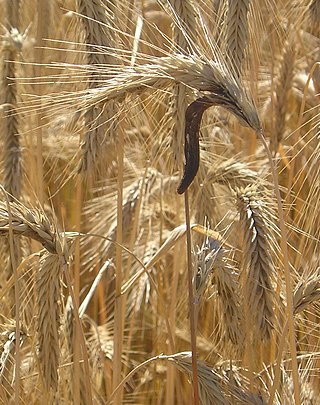
Claviceps purpurea is an ergot fungus that grows on the ears of rye and related cereal and forage plants. Consumption of grains or seeds contaminated with the survival structure of this fungus, the ergot sclerotium, can cause ergotism in humans and other mammals. C. purpurea most commonly affects outcrossing species such as rye, as well as triticale, wheat and barley. It affects oats only rarely.
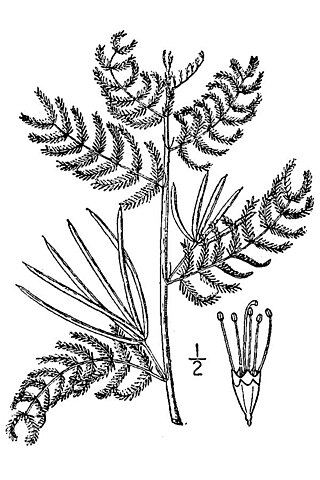
Desmanthus leptolobus, known as prairie mimosa, prairie bundleflower or slenderlobe bundleflower, is a flowering plant of the genus Desmanthus. It is native to Kansas, Oklahoma, and Texas and has spread to Missouri and New Mexico. It is often locally abundant over large expanses of rolling prairie.

Phalaris minor is a species of grass native to North Africa, Europe, and South Asia. The bunchgrass is widely naturalised elsewhere.

Papaver glaucum, the tulip poppy, Turkish tulip or Turkish red poppy, is a poppy found in the region of Anatolia.
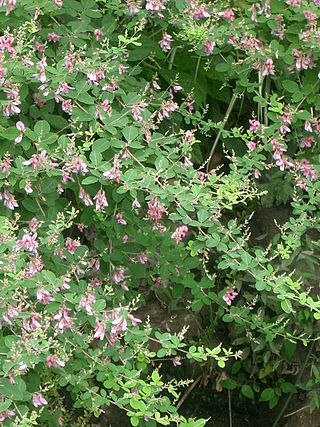
Lespedeza bicolor is a species of flowering plant in the legume family known by the common names shrubby bushclover, shrub lespedeza, and bicolor lespedeza. It is native to eastern Asia, ranging from southeastern Siberia to eastern China, Mongolia, Korea, and Japan. and it is widely grown as an ornamental plant. In some regions, such as the southeastern United States, it grows in the wild as an introduced and invasive species.
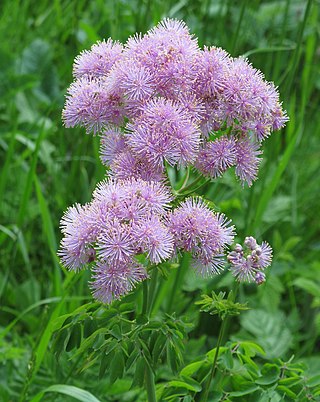
Thalictrum aquilegiifolium is a species of flowering plant in the buttercup family Ranunculaceae. It is known by the common names Siberian columbine meadow-rue, columbine meadow-rue, French meadow-rue, and greater meadow-rue. Its native range extends through Europe and temperate Asia, with a naturalized distribution in North America limited to New York and Ontario.
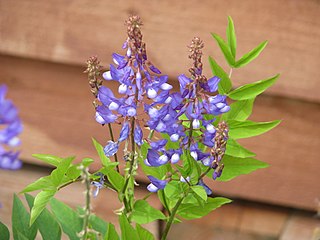
Galega orientalis is a species of flowering plant in the Fabaceae, the legume family. It is known commonly as fodder galega and eastern galega. It is cultivated as a fodder and forage for livestock.


















